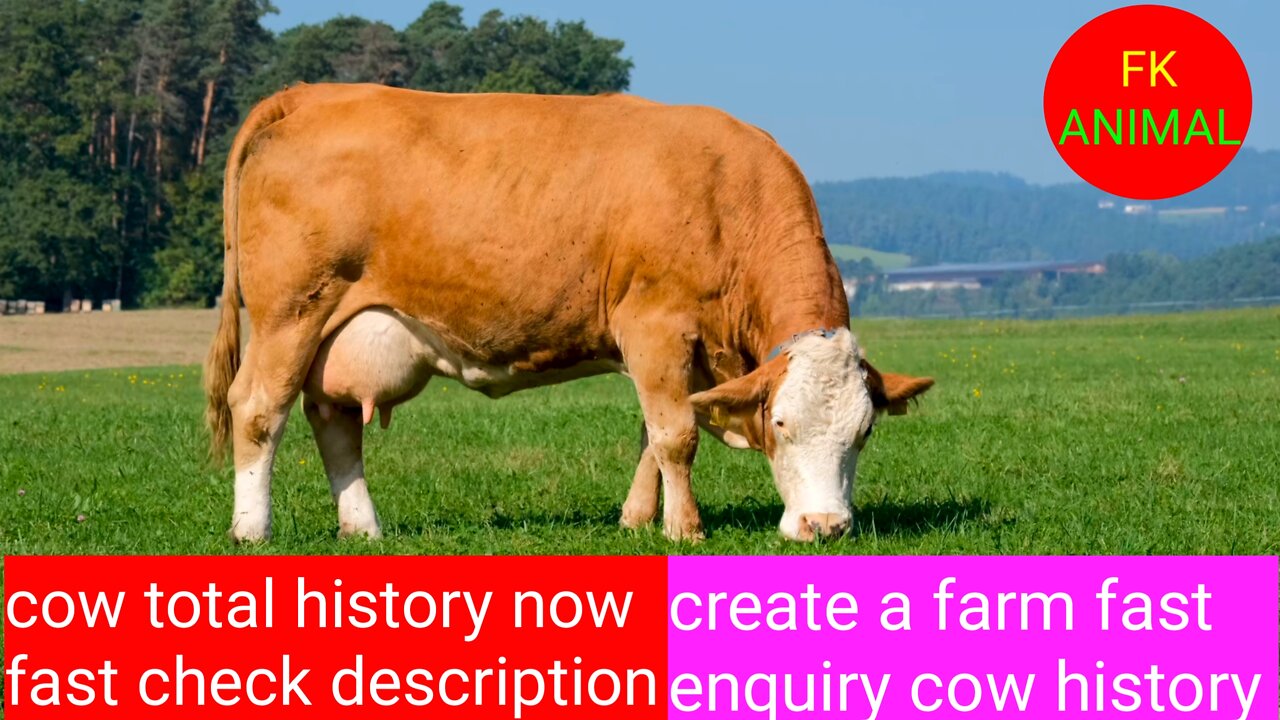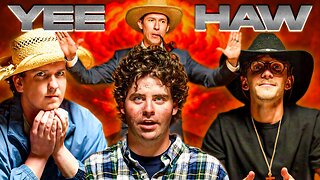Premium Only Content

How to A cow total history
Welcome my channel FK ANIMAL
HOW TO A COW TOTAL HISTORY
Cow
Farm Animal
Cattle, or cows, are the most common type of large domesticated ungulates. They are a prominent modern member of the subfamily Bovinae, are the most widespread species of the genus Bos, and are most commonly classified collectively as Bos taurus.
Lifespan: 18 – 22 years
Scientific name: Bos taurus
Gestation period: 283 days
Family: Bovidae
Class: Mammalia
Mass: Male: 1,100 kg (Adult, Bull), Female: 720 kg (Adult, Cow)
Cow, in common parlance, a domestic bovine, regardless of sex and age, usually of the species Bos taurus. In precise usage, the name is given to mature females of several large mammals, including cattle (bovines), moose, elephants, sea lions, and whales.
Domestic cows are one of the most common farm animals around the world, and the English language has several words to describe these animals at various ages.
A baby cow is called a calf. A female calf is sometimes called a heifer calf and a male a bull calf. A heifer is a female that has not had any offspring. The term usually refers to immature females; after giving birth to her first calf, however, a heifer becomes a cow.
An adult male is known as a bull. Many male cattle are castrated to reduce their aggressive tendencies and make them more tractable. Young neutered males, which are primarily raised for beef, are called steers or bullocks, whereas adult neutered males, which are usually used for draft purposes, are known as oxen.
A group of cows, cattle, or kine (an archaic term for more than one cow) constitutes a herd. English lacks a gender-neutral singular form, and so “cow” is used for both female individuals and all domestic bovines.
The size and weight of a cow is highly dependent on the breed. Mature males weigh 450–1,800 kg (1,000–4,000 pounds) and females weigh 360–1,100 kg (800–2,400 pounds).
Both males and females have horns, and although these may be short in many breeds, they can grow to be spectacularly large, such as in Texas longhorns and African Ankole-Watusi cows.
Some breeds are genetically polled (hornless), and many other cows may be dehorned (that is, have their horn buds destroyed) at young age to make them easier to transport and safer to work around. Cows are renowned for their large milk-producing (mammary) glands known as udders, which possess four teats (nipples).
Biology Of Cow
Anatomy
Cattle are large quadrupedal ungulate mammals with cloven hooves. Most breeds have horns, which can be as large as the Texas Longhorn or small like a scur. Careful genetic selection has allowed polled (hornless) cattle to become widespread.
Digestive system
Cattle are ruminants, meaning their digestive system is highly specialized to allow the use of poorly digestible plants as food.
Cattle have one stomach with four compartments, the rumen, reticulum, omasum, and abomasum, with the rumen being the largest compartment. The reticulum, the smallest compartment, is known as the "honeycomb".
The omasum's main function is to absorb water and nutrients from the digestible feed. The omasum is known as the "many plies". The abomasum is like the human stomach; this is why it is known as the "true stomach"
Cattle are known for regurgitating and re-chewing their food, known as cud chewing, like most ruminants. While the animal is feeding, the food is swallowed without being chewed and goes into the rumen for storage until the animal can find a quiet place to continue the digestion process.
The food is regurgitated, a mouthful at a time, back up to the mouth, where the food, now called the cud, is chewed by the molars, grinding down the coarse vegetation to small particles. The cud is then swallowed again and further digested by specialized microorganisms in the rumen
Gestation and size
The gestation period for a cow is about nine months long. A newborn calf's size can vary among breeds, but a typical calf weighs between 25 to 45 kg (55 to 99 lb). Adult size and weight vary significantly among breeds and sex.
Steers are generally killed before reaching 750 kg (1,650 lb). Breeding stock may be allowed a longer lifespan, occasionally living as long as 25 years. The oldest recorded cow, Big Bertha, died at the age of 48 in 1993.
Reproduction
On farms it is very common to use artificial insemination (AI), a medically assisted reproduction technique consisting of the artificial deposition of semen in the female's genital tract.
It is used in cases where the spermatozoa can not reach the fallopian tubes or simply by choice of the owner of the animal.
It consists of transferring, to the uterine cavity, spermatozoa previously collected and processed, with the selection of morphologically more normal and mobile spermatozoa.
A cow's udder contains two pairs of mammary glands, (commonly referred to as teats) creating four "quarters". The front ones are referred to as fore quarters and the rear ones rear quarters.
Weight
The weight of adult cattle varies, depending on the breed. Smaller kinds, such as Dexter and Jersey adults, range between 272 to 454 kg (600 to 1,000 lb). Large Continental breeds, such as Charolais, Marchigiana, Belgian Blue and Chianina, adults range from 635 to 1,134 kg (1,400 to 2,500 lb).
British breeds, such as Hereford, Angus, and Shorthorn, mature between 454 to 907 kg (1,000 to 2,000 lb), occasionally higher, particularly with Angus and Hereford.
Bulls are larger than cows of the same breed by up to a few hundred kilograms. Chianina bulls can weigh up to 1,500 kg (3,300 lb); British bulls, such as Angus and Hereford, can weigh as little as 907 kg (2,000 lb) to as much as 1,361 kg (3,000 lb).
-
 1:50
1:50
WGBA
3 years agoHistory of Mushing
301 -
 2:28
2:28
How to Rumble
3 years agoHow To Rumble: History and Notifications
9.83K152 -
 3:23
3:23
WXYZ
3 years agoCelebrating Black History
29 -
 2:55:46
2:55:46
TimcastIRL
7 hours agoTrump THREATENS To SUSPEND Habeas Corpus To BYPASS Judges Blocking Deportation | Timcast IRL
264K173 -
 2:29:18
2:29:18
Laura Loomer
6 hours agoEP119: Trump's First 100 Days: Were Promises Kept?
65.5K14 -
 57:01
57:01
Man in America
10 hours ago🚨 RED ALERT: Miscarriages & Infertility Are SKYROCKETING—OBGYN Warns of Population Collapse
34.8K49 -
 23:33
23:33
Friday Beers
7 hours ago $11.92 earnedTensions Explode During Wild West Mafia Game!
55.3K4 -
 1:22:39
1:22:39
Badlands Media
23 hours agoAltered State S.3, Ep. 26
62.3K13 -
 5:42:28
5:42:28
JdaDelete
9 hours ago $3.93 earnedBanjo-Kazooie - wedNESday
47.7K5 -
 30:09
30:09
Iggy Azalea
11 hours ago $6.28 earnedplaying motherland
65.9K22